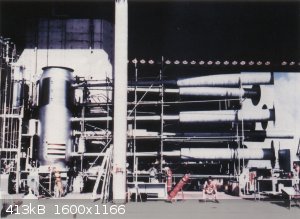metalresearcher
National Hazard
   
Posts: 757
Registered: 7-9-2010
Member Is Offline
Mood: Reactive
|
|
Does D-T fusion require Lithium ?
The Deuterium - Tritium fusion, as used by e.g. ITER, requires Li to breed the tritium. It is used as a fissible as neutrons from the reaction split
the core of 6-Li and 7-Li to Tritium which can be used as new feedstock for the D-T reaction.
If it really needs Li, then fusion is not so sustainable as advocated, because Li (also needed for batteries) is rather scarce.
Is that true that Li is needed as consumable for fusion ?
|
|
|
zerodan
Harmless

Posts: 27
Registered: 4-4-2019
Member Is Offline
|
|
Quote: Originally posted by metalresearcher  | The Deuterium - Tritium fusion, as used by e.g. ITER, requires Li to breed the tritium. It is used as a fissible as neutrons from the reaction split
the core of 6-Li and 7-Li to Tritium which can be used as new feedstock for the D-T reaction.
If it really needs Li, then fusion is not so sustainable as advocated, because Li (also needed for batteries) is rather scarce.
Is that true that Li is needed as consumable for fusion ? |
It isn't.
The first thermonuclear test, Ivy Mike didn't use lithium,
https://en.wikipedia.org/wiki/Ivy_Mike
"Due to its physical size and fusion fuel type (cryogenic liquid deuterium), the "Mike" device was not suitable for use as a deliverable weapon"
It's just more convenient to store a solid rather than pure hydrogen in any form, because to achieve the same density you need extreme conditions
pressure or temperature wise.

|
|
|
Jome
Hazard to Others
  
Posts: 154
Registered: 10-6-2004
Location: Soutwest sweden
Member Is Offline
Mood: desiccated
|
|
If you look up fusion triple products of various reaction you'll see that producing net energy from Deuterium-deuterium fusion is significantly more
difficult than deuterium-tritium. A nuclear bomb is kind of different from trying to use DD-fusion on a smaller, "powerplant-suitable" scale, f.ex the
proportion of energy that uselessly leaves the on-going reaction will be much higher if instead of a bomb with hundreds of kg D2 we're using a little
droplet in something like the NIF (national ignition facility), the same goes for "continual" reactions where, say, D+D forms tritium, which fuses
with remaining deuterium more easy, such reactions simply won't happen on a small scale.
I wouldn't say Lithium is particularly scarce, seawater has a concentration of 180 ppb, which means that there is 234 GT or so of it in the oceans.
[Edited on 11-12-2021 by Jome]
[Edited on 11-12-2021 by Jome]
|
|
|
zerodan
Harmless

Posts: 27
Registered: 4-4-2019
Member Is Offline
|
|
Quote: Originally posted by Jome  | If you look up fusion triple products of various reaction you'll see that producing net energy from Deuterium-deuterium fusion is significantly more
difficult than deuterium-tritium. A nuclear bomb is kind of different from trying to use DD-fusion on a smaller, "powerplant-suitable" scale, f.ex the
proportion of energy that uselessly leaves the on-going reaction will be much higher if instead of a bomb with hundreds of kg D2 we're using a little
droplet in something like the NIF (national ignition facility), the same goes for "continual" reactions where, say, D+D forms tritium, which fuses
with remaining deuterium more easy, such reactions simply won't happen on a small scale.
I wouldn't say Lithium is particularly scarce, seawater has a concentration of 180 ppb, which means that there is 234 GT or so of it in the oceans.
[Edited on 11-12-2021 by Jome]
[Edited on 11-12-2021 by Jome] |
I think you're right. My response addressed the subject of this thread, I interpreted it as whenever lithium is strictly required for fusion, not
whenever it's practically required which is what the first post is getting at.
Which it still isn't if you find a better method of producing tritium, but I don't know too much about that.
As to lithium being "abundant" in the ocean, it really depends on the energy you have to spend to separate and purify it, which probably is a lot.
|
|
|
neptunium
National Hazard
   
Posts: 989
Registered: 12-12-2011
Location: between Uranium and Plutonium
Member Is Offline
|
|
out of the two naturally occurring isotopes of Li, only Li6 is the useful one for thermonuclear weapons, but even with its low natural abundance, Li
hydride and deuterides are a very interesting chemical sought after by nuclear power wannabe for decades. (maybe even today ?) other material nd
development have been made and are available and used today.
|
|
|
Ubya
International Hazard
    
Posts: 1247
Registered: 23-11-2017
Location: Rome-Italy
Member Is Offline
Mood: I'm a maddo scientisto!!!
|
|
it is true that lithium isn't a renewable source, but considering the scale of its use for power generation is pretty important.
From iter.org it is speculated that a 1000MW reactor will use 250Kg of 50:50 deuterium-tritium a year, that means that 250Kg of Lithium-6 will be
used.
let's assume the global electricity generation capacity is 8.000GW, if all of that was from fusion reactors, the global annual consumption of lithium
for power generation would be 2.000 metric tons
Last year 82,000 metric tons of lithium were mined for the production of batteries.
So while not great, by just using lithium we'd be able to run our civilization for 7000 years at our current rate.
Once D+T fusion has been tamed and optimized the logical next step is to go with D+D fusion, and with that you really don't have to worry about finite
resources
https://www.iter.org/sci/FusionFuels
---------------------------------------------------------------------
feel free to correct my grammar, or any mistakes i make
---------------------------------------------------------------------
|
|
|